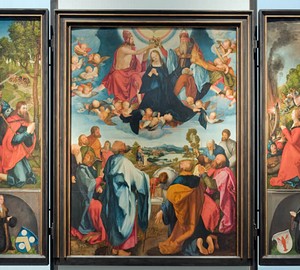
Description of the picture:
Geller’s Altar (Altar of the Ascension of Mary) – Matthias Grunewald, triptych. 1507-1511, 1614-1617. Wood, tempera. 190 x 260 cm
This wonderful work of art has a remarkable composition of the masters who worked on it. Two talented representatives of German art – Dürer and Grunewald – in close cooperation performed this altar in the form of a classical church triptych. Almost a hundred years later, another artist made a copy of it – Harrich, thanks to which this image was at least partially preserved to this day.
The main part of the altar – the central element and the inner wings – were made by Albrecht Dürer, or rather, the artists of his workshop under his leadership and with his participation. Only four paintings for the outer wings on the right and left were commissioned by Matthias Grunewald. The middle part of the altar of the Dürer brush burned down in the XVIII century and we can only judge it by the preserved copy of Harrich.
Due to the fact that the monasteries were ruined and liquidated during the period of secularization, the altar was divided into parts. That is why some of its surviving elements are now located in various cities. 4 paintings of Grunewald have been preserved, of which Saint Cyriac and Saint Lawrence are now in Frankfurt am Main, and Saint Lucia and Saint Elizabeth of Thuring are in Karlsruhe.
Performed grisaille paintings. This is a rather complicated painting technique, requiring work only in tones of the same color, that is, in monochrome. Thanks to this technique, it is possible to create a visual impression of a bas-relief, since due to the restrained selection of colors the image looks convex, voluminous.
This is a time-consuming image method, since paints have to be layered with the finest strokes to reproduce the shape of objects. In portrait images, this is even more difficult. But Grunewald masterfully coped with the task. Despite the very limited color scheme, his paintings for the altar look spectacular, beautiful, not inferior in expressiveness to the colorful central part and sidewalls.
The faces of the saints are living, with recognizable facial features. The women depicted by Matthias are very similar to the Madonnas of Italian masters, for example, in the guise of a saint (presumably Saint Lucia), one can find similarities with Venus Botticelli. At the same time, she recalls Judith from the famous canvass of Lucas Cranach the Elder, and many other female portraits of that time.
Despite the small number of surviving works of the master, we can judge him as one of the most significant and talented artists of the German Renaissance."